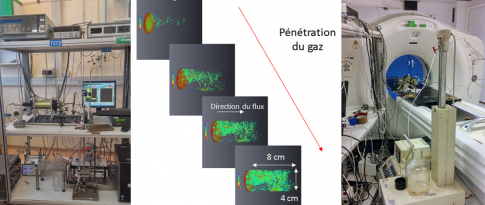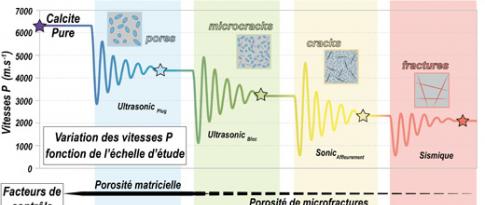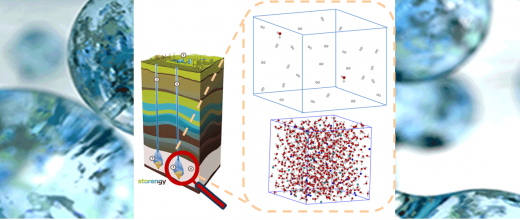To address the challenges of the energy transition, the subsurface has an important role to play, both in terms of providing resources and offering storage solutions. For example, the subsoil is necessary to produce heat from geothermal drilling, to recover rare earths such as lithium, present in dissolved form in some underground water, and to identify geological conditions favorable to hydrogen formation. It is also of interest in terms of storage, either temporary or permanent, as significant volumes may be available in porous underground media to temporarily store energya or, in the longer term, to trap CO2 captured from industrial facilities.
Numerical models can help gain a better understanding of the subsurface with a view to its long-term management and optimal use. Developed for a number of years now at IFPEN, initially for the petroleum industry, such models cover scales ranging from the sedimentary basin to the reservoir:
- basin modelsb are designed for modeling the stratigraphic environmentc (DionisosFlowTM) or modeling the entire geological history of the basin considered, with a view to deducing its properties and the location of the fluids it contains (TemisFlowTM);
- for smaller time and space scales, reservoir models predict the dynamic behavior of fluids and fractures present in the underground environment (PumaFlowTM, FracaFlowTM, TightFlowTM).
These tools also form an excellent basis for addressing problems relating to the production and storage of non-fossil energy or gas. Adaptation research is thus underway at IFPEN to add new functionalities to the models to address these emerging needs. Examples of this research include:
- consideration with TemisFlowTM of heat transfer via the faults present in a basin, in order to better estimate and locate its geothermal potential;
- modeling movements of CO2 injected into the underground environment, as well as the resulting geochemical interactions with the rock, via the development of the CooresFlowTM software based on elements from PumaFlowTM.
It has also appeared necessary to integrate several scales and/or several types of physical analyses within the same model, as is already done when:
- combining “basin” and “reservoir” tools in order to identify the location of potential CO2 storage zones in little-explored regions;
- integrating geomechanical aspects in such a way as to better represent tectonic and mechanical effects in the underground environment.
The risks associated with these new uses of the underground can be studied using approaches, either currently available or under development, in the field of uncertainty quantification (CougarFlowTM).
This research is being conducted on a partnership basis, within the context of the Ademe Aquifer-CO2Leak project[1] or the European SENSE project[2], for example. In the former project, the use of CooresFlowTM was validated to predict CO2 flow in the underground environment, comparing numerical results with data from an experimental site in Saint-Emilion. In the latter, a reservoir model has been combined with a geomechanical model to monitor CO2 storage sites from satellite measurements of surface deformation.
Other collaborative projects, based on multi-scale and multi-physical modeling, are under way with TotalEnergies. One of these is examining approaches combining small and large scales with a view to better predicting some underground properties during CO2 storage (figure 1). Another is aimed at combining, for the first time in an industrial setting, a basin model and a geomechanical model[3] to better predict natural sedimentary rock fracturing under the effect of tectonic stress (figure 2).
This research illustrates the evolution of underground modeling deployed by IFPEN to address the technological challenges of the energy transition, as well as the mobilization of its researchers as they seek to make progress in this field.
Click on pictures to enlarge
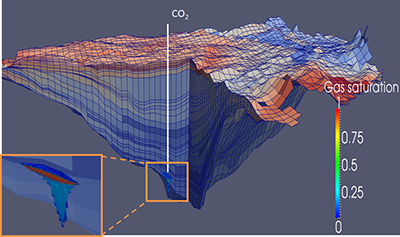
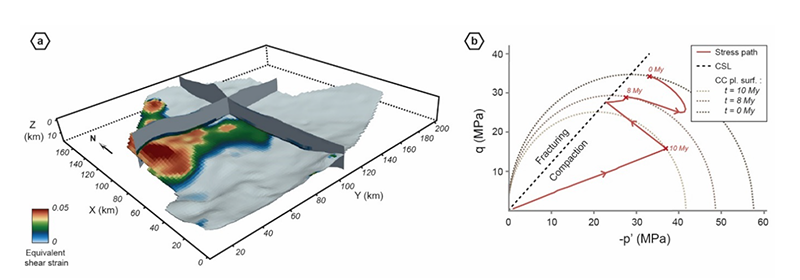
a) combined 3D model and b) evolution of stresses in a cell
a- For example natural gas, compressed air or hydrogen.
b- Between 10,000 and 100,000 km2.
c- Succession of different geological layers or strata.
Publications:
[1] O. Gassara et al, The Aquifer-CO2Leak project: Numerical modeling for the design of a CO2 injection experiment in the saturated zone of the Saint-Emilion (France) site, International Journal of Greenhouse Gas Control, 2021. https://doi.org/10.1016/j.ijggc.2020.103196.
[2] S. Bouquet et al., Analysis of surface movement through conceptual and coupled flow-geomechanics models, an example of surface monitoring assessment for CCS project, Trondheim Conference on CO2 Capture, Transport and Storage, 2021.
[3] J. Berthelon, A. Brüch, D. Colombo, J. Frey, R. Traby, A. Bouziat, M.C. Cacas-Stentz, T. Cornu, Impact of tectonic shortening on fluid overpressure: Insights from the Neuquén basin, Argentina, Marine and Petroleum Geology, Volume 127, 2021. https://doi.org/10.1016/j.marpetgeo.2021.104933.
Scientific contact: nicolas.maurand@ifpen.fr
You may also be interested in
A scientific visitor helps improve the monitoring of CO2 storage facilities
Over the past ten years, IFPEN has been conducting research on the geochemical monitoring of the geological storage of CO2, in order to gain a better understanding of th
Characterization and modeling of the facies(a)-eogenesis(b) couple, initial state of carbonate reservoirs (HDR 2017)
Carbonate reservoirs present significant heterogeneities (in terms of types and scales) associated with the biological origin of sedimentsc, as well as t







